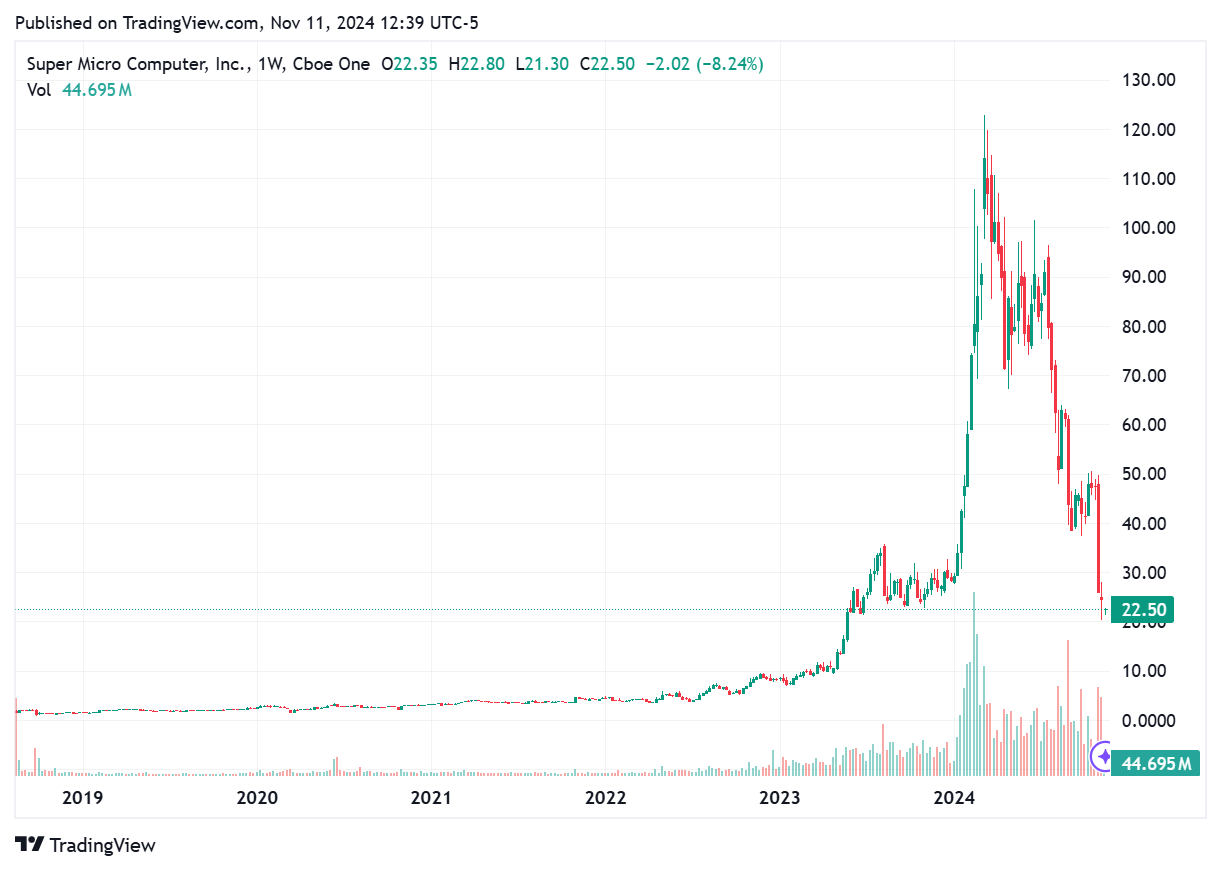Why was Supermicro so super?
💥A 10-bagger stock in 2023 💥. What happened in the last 18 months and what to do now?
Disclosure: Opinions are my own. Not financial advice. 😛
In the past 2 years, AI has got a lot of attention. The companies that are considered “AI companies ($NVDA, $SMCI)” have seen their stock prices double, triple or in some cases, even go up 10x at the peak level.
Supermicro is one superstar and its stock price went from $10 to $100 in one year🚀. In this piece today, we are going to talk about the basics of supermicro including its brief history, business model and the reasons behind the 10x move. 🚀
In the next article, we will perform in-depth financial analysis and discuss its future aspects, and most importantly, what to do with the stock now. 🤔
Please subscribe below so that you don’t miss the update!
Part 1 - a Brief History, Business Model and Key Products.
Supermicro was founded in San Jose, California in 1993 by Charles Liang. They make server and storage systems that are used in enterprise data centers and cloud computing.
The majority of its revenue comes from selling servers. You might ask, hmm what is a server? Let’s give a quick teach-in on server⬇️:
What is a server?
For simplicity, you can think of server as a giant computer and it is full of information. When you visit a website, stream a video, or check your email, your device will send a request to the server, and the server then sends back the information you requested for back to you.
Why do we need servers? The most obvious benefit is being able to share information easily. Instead of each computer storing a copy of the same information, people can just connect to the server to get the information when they need it.
Put it in other word, the invention of internet relies on servers. Without servers, we would not be able to access the internet as the interconnected network that it is today.
So how is a server being made and what role does Supermicro play in this?
There are many electronic components when assembling a server. Supermicro usually procures these components. Then they design their server systems and assemble the components together.
Their customers are the end users who buy servers and put them in data centers or local server room. Typical customers include the large tech giants such as Amazon, Google and Microsoft. They either provide cloud computing services to external customers or they use the servers to handle internal workloads. For example, Meta is investing heavily in building out data centers and they operate data centers to handle their platform’s massive data and user traffic.
Another type of customers are the large enterprises such as financial institutions or telecommunication companies. They need servers to manage large datasets and data flow.
Key competition
The end market that Supermicro plays in is quite competitive 🤯. There are a handful of players in this market. SMCI competes with the large technology vendors such as Dell, Hewlett-Packard Enterprise as well as the ODM (original design manufacturers) mostly based in Taiwan, including Foxconn, Quanta and Wiwynn.
💥A quick teach-in on ODM vs OEM model ⬇️:
ODM is Original Design Manufacturers. Whereas OEM is Original Equipment Manufacturer. There are couple differences:
On the design side: ODM is usually pre-designed and ready-made, so their time to market is generally faster (we will touch this point later on regarding AI servers). On the other hand, OEM requires more time before going to the market, as the OEM such as Dell or Lenovo will work with enterprise customers and design their products tailored to the enterprises’ specific needs.
On the cost side, since there is more customization that comes with the OEM model, it typically has a better margin profile than ODM model.
On the customer side, the hyperscaler customers prefer to use ODM as they usually have their own in-house design capabilities, so they collaborate with these ODMs to make servers that suit their own needs. And since they are buying in large quantities, the competitive cost offered by ODM is a big plus.
On the other side, Dell, HP Enterprise tend to serve enterprise customers because they have already built strong enterprise relationships over the years by providing a one-stop shop services. They also have dedicated sales team to support their customers.
As for SMCI, it’s primarily an OEM in that it designs and manufacturers its own server hardware. Given the intense competition in this industry, SMCI’s margin in the past has not been very high. Operating margin before the AI mania was in the mid-single digit range (5% or so).
Stock’s historical perspective - unexciting story with stagnant growth and low margins
For a long time, Supermicro didn’t get much attention. The stock price was trading in the range of $2 and $5 for the most time before 2022. People viewed it as a low-quality low margin server business, which wasn’t untrue. Revenue growth was stagnant as server growth is stagnant at low single digit to mid-single digit. And it’s hard to differentiate itself with other Taiwan based server makers such as Quanta, Wistron etc.

These server makers purchase components and assemble everything. As you can imagine, it’s not rocket science and the margin is not super high.
Historically the company’s revenue hasn’t been growing as fast mostly because demand for servers are not that high. You ship servers to enterprise or cloud customers, and they only need to procure new servers every couple of years. Historically the growth rate for servers is in the low single digit range.
Institutional investors didn’t like them for a long time. Supermicro had some serious corporate governance issues and it didn’t do a good job with financial disclosure.
In 2018, the company delayed the release of its annual report. Eventually after several warnings issued by the US Securities and Exchange Commission, the stock got delisted and its stock price plunged. Many portfolio managers during that time suffered from terrible losses when that happened.
Part Two - Why did the stock go up 10x?
AI servers
However, this perception all changed when the “AI mania” occurred in early 2023.
Supermicro had started working with Nvidia on making “AI servers” earlier than its competitors. An AI server, simply put, is a server with accelerated computing unit such as Graphics Processing Unit or GPU (made by Nvidia).
AI servers are critical because of GPU’s strong processing power to train a large amount of datasets and models.
As a result, when ChatGPT went crazy in 2023 and companies need a significant amount of AI servers to train large language models, Supermicro has a first mover advantage. When peers such as Dell and HP enterprise were still trying to build AI servers, Supermicro already has already secured orders with key customers.
The arrival of AI servers changed the story meaningfully. Investors got super excited about the significant revenue expansion opportunities.
Think about it. A traditional server costs about $5,000. An AI server costs on average $200K. each has the multiple expansion of 40x.
So if every traditional server gets replaced by AI server, without changing the total number of servers shipped each year, that’s a huge boost to Supermicro’s total addressable market.
Unit economics and operating leverage
If Supermicro maintains its gross margin for 15% but its quarterly revenue grow from $1B to $4B. That means its gross profit dollars on absolute basis also quadrupled from $150M to $400M. If the change in operating expense is minimal (growing maybe from $100M per quarter to $150M per quarter), a simple math suggests the company’s operating profit grows from $50M ($150M-$100M) to $250M ($400M-$150M). That’s 5x increase in operating profit, which is very meaningful to the bottom line profitability.
In the next piece, I will write about the financial impact form AI contribution and analyze different scenarios in more depth. Subscribe so you don’t miss the update!
Challenges?
From the article above, it probably made a lot of sense that the stock has done quite well in the months following AI mania. However, the stock has pulled back meaningfully since March 2024, from the peak of $100 to $25 now.
There are multiple reasons for it, increasing competition, corporate governance issues (accounting and delay in the release of annual report), and demand uncertainty around AI servers. We will explore these topics in more detail in the next piece.
At the end, we will walk through the different scenarios and what to do with the stock a the current level. Has it finally corrected to a level with attractive upside? Or is it a value trap now?








